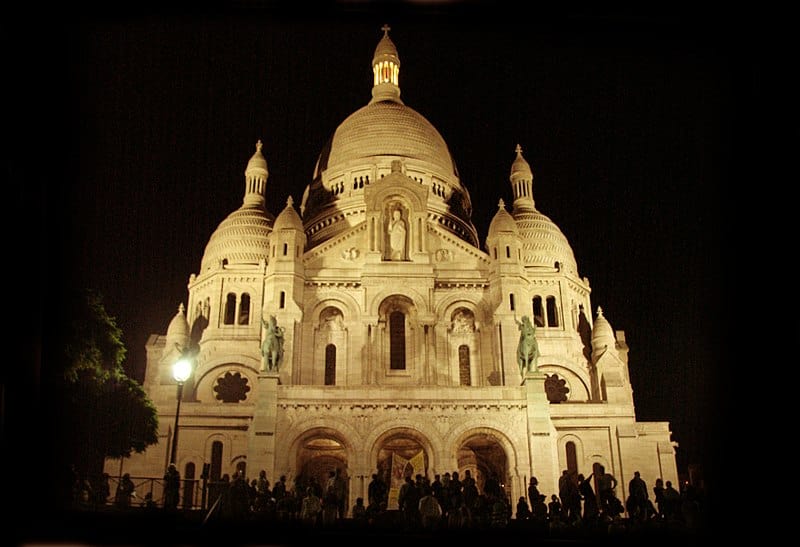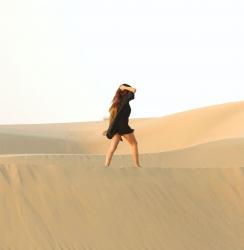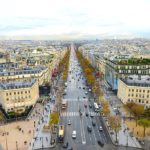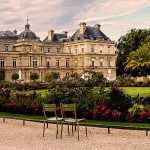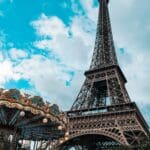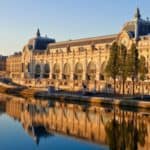Top 10 Reasons to Visit the Basilica of Sacre Coeur
The Basilica of Sacre Coeur is one of the most recognizable landmarks in Paris and the world. It is the crowning glory that sits at the very top of Montmartre hill in the 18th arrondissement, attracting millions of visitors per year as it hovers over the French capital.
Paris is home to many a beautiful church. In the center you’ll find the incredible structure that is Notre Dame. Saint-Séverin and the Russian church are another two of my favorites. Saint-Étienne-du-Mont is another wonder that is often overlooked by travelers to Paris.
There is something undoubtably special about the Sacre Coeur, however. Something incredibly whimsical and fairytale-like. The white stone against the blue sky isn’t a sight that gets old very easily.

Basilica of Sacre Coeur – by Mark Fischer – Wikimedia Commons
There is much debate around whether or not making the hike up to the church is worth it. Many people report excessive haggling from vendors and artists putting a damper on the experience and suggesting that that church is perhaps best viewed from a distance.
Having made the journey up a number of times I must strongly disagree. Sacre Coeur is undoubtably best viewed from up close and inside of the vicinity. A wonder of a landmark in Paris; here are 10 reasons to pay it a visit.
1. The Architecture at the Basilica of Sacre Coeur
Unbeknownst to some, the same architect behind Notre Dame was responsible for the construction of the Scare Coeur as well.
In 1875 a man named Paul Abadie began construction of the landmark after having won the competition held by the city of Paris to find the man for the job. While Abadie was the frontman in the beginning of the job, he unfortunately didn’t live to see the church’s completion. He passed away in 1884, with 40 years of construction still required on the church.
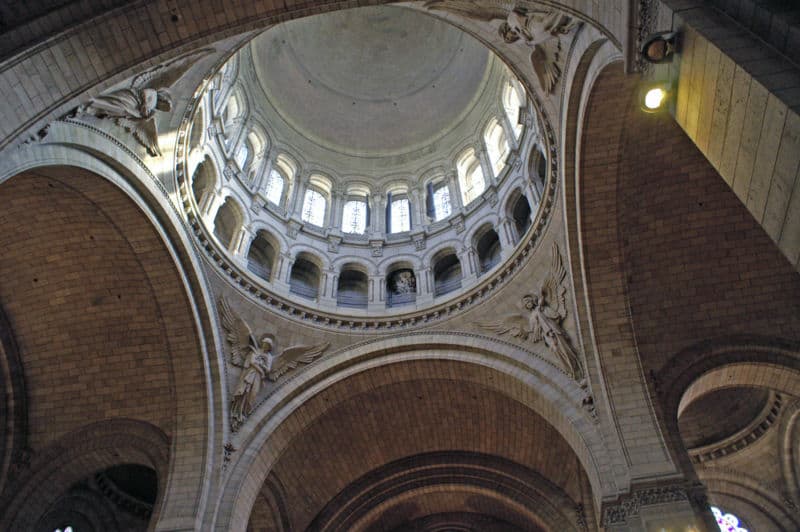
Basilica of Sacre Coeur – by Didier B – Wikimedia Commons
Sacre Coeur is an architectural wonder both inside and out. The stone for the structure was taken from the Château-Landon quarries in Paris that calcifies under wet weather conditions — this acts as a natural bleach and is responsible for the chalk tone of the entire church.
The interior is everything you’d expect from a lavish basilica in Europe. The symmetry of the archways are what makes the inside so mind blowing. There are also hand painted murals that make up biblical scenes across the ceiling, in which you can lose your thoughts for hours on end.
2. The View from the Basilica of Sacre Coeur
One of the biggest motivations for making the trek up to the church on the hill is the view that comes with it. This part of the 18th arrondissement towers over the city of Paris, giving one panoramic views of the south and surrounding arrondissements.
Even if you aren’t mad about church viewing, this view of Paris is a very good reason to head to the hilltop. You will see that many others have the same idea, and the viewing spaces outside of the church structure are usually packed with visitors.
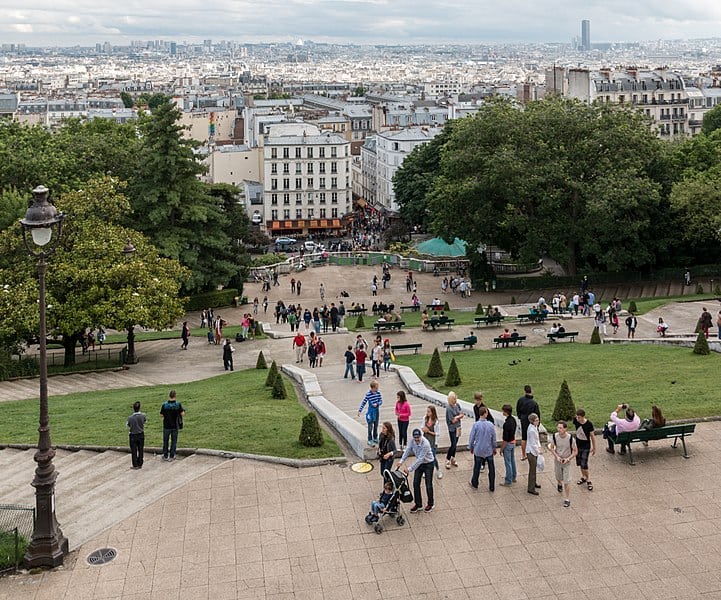
View from Sacre Coeur – by Dietmar Rabich – Wikimedia Commons
Landmarks in Paris have the tendency to be easily identifiable even from a far away distance; think of the Eiffel Tower and how iconic that shape is to the human eye.
Once at the the top of the hill you’ll be able to sit and pick out other well known Parisian landmarks across the city scape. Seeing how each one exists in relation to the rest is super interesting — you forget just how big this city actually is.
3. Surrounding Montmartre at the Basilica of Sacre Coeur
Montmartre is the artists hub of Paris. With this comes a certain laid-back, almost carefree, lifestyle through the streets and attractions that make this district was it is.
During the 19th century Montmartre was one of the more affordable places to live in Paris due to its precarious location on the hill of the 18th arrondissement. It was seen as somewhat undesirable and as a result cost of living was considerably cheaper.
Cheap rent brings artists, as the saying goes. And so saw the beginning of the creative neighborhood that we know and love today.

Montmartre Streets – by Anyul Rivas – Wikimedia Commons
Aside from the Sacre Coeur there are many other attractions within the Montmartre boundary. As you work your way up from the bottom of the hill, near the Pigalle strip, you’ll pass historic sites such as the Montmartre Museum, La Maison Rose and the Cemetery of Montmartre.
Blindly navigating the winding streets that take one up the hill can be confusing. It is sometimes a better idea to join a free guided walking tour where an experience guide can take you past all the sites and give you the relevant history and information for each.
4. Street Artists at Basilica of Sacre Coeur
One thing you’ll quickly learn about Paris is that wherever large crowds of people are there are street artists following close behind. The foot traffic that the Sacre Coeur attracts means that the surrounding grounds of the church are constantly filled with people.
Before I go further, let me mention that the beautiful view over Paris from the top of the hill is accessible both during the day and by night. If you are not one for crowds but would like to bask in the panoramic visuals consider doing a night walk up to the church.
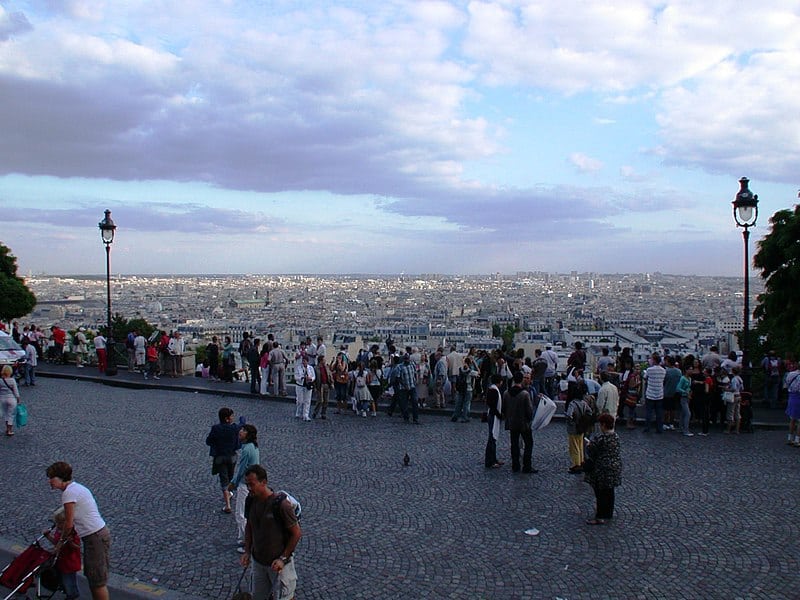
Artists and tourists at Sacre Coeur – by Riggwelter – Wikimedia Commons
Back on subject; Paris is filled with street artists specializing in different mediums all trying to make a quick buck to get from one day to the next. At the Sacre Coeur you’ll encounter many buskers, sketch artists, photographers and occasionally mimes all forming part of the outside ambiance of the basilica.
5. The Steps of the Basilica of Sacre Coeur
In conjunction with the afore mentioned point, the Sacre Coeur’s outside section features a plethora of steps that lead up and down the establishment. These steps have become somewhat of an attraction of their own in the neighborhood of Montmartre — they are regarded as a central meeting point for visitors to this area.
The steps are so wide that the hundreds of individuals outside of the basilica at any give time are able to make use of them as sort of “chilling” ground.

The Steps of the Basilica of Sacre Coeur – by Dietmar Rabich – Wikimedia Commons
Some people sit alone and red in the sun; couples get cosy and enjoy the view of the city sprawled in front of them; families with children take up their own few stairs and enjoy pre-packed lunches or full picnics right there on the stairs.
Since the inside of the Basilica of Sacre Coeur remains a space of silence and respect, the stairs outside become the social element of the landmark, providing place for people to extend their time at the attraction.
6. The Dome of the Basilica of Sacre Coeur
While the front of the Sacre Coeur provides a somewhat one sided view of the city of Paris, the church’s dome tower is able to give visitors a 360 degree view of the beautiful city.
The dome is accessible to the public by a flight of stairs inside the basilica. While there is no charge to visit the church, there is a small fee to gain access to the dome tower.

The dome at the Sacre Coeur – by Pline – Wikimedia Commons
Once at the top you’ll be able to spot just about every major landmark in the city. It is recommended to take a pair of binoculars with if you have access to some.
There are many incredible viewpoints around Paris where city views are absolutely unreal. The top of Montparnasse Tower or, of course, the Eiffel Tower, are two others worth experiencing while in town. None, however, have the same all inclusive view that the dome of the Sacre Coeur is able to offer thanks to its circular foundation.
7. The Sinking House at the Basilica of Sacre Coeur
The sinking house is a lot less exciting when you learn that the house itself was never actually sinking in the first place. It’s an illusion; a trick of the eye that creative picture takers were able to figure out thanks to the unique slope of the Montmartre hill.
In order to see the house for yourself you’ll have to start at the front entrance of the Sacre Coeur. Make your way down the steps, moving away from the church which should at this point be behind you.
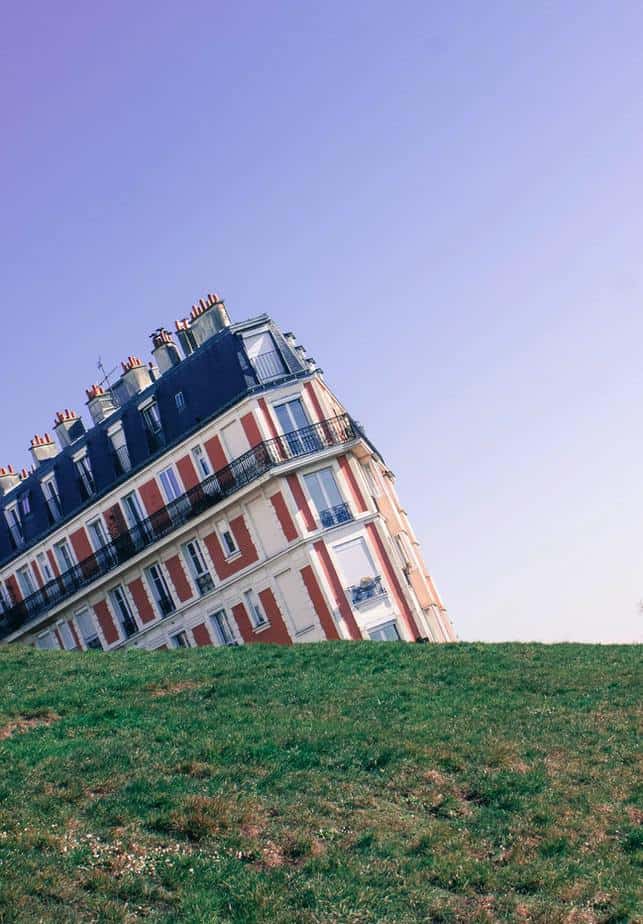
The sinking house – by Pauline Loroy – Unsplash
As you move down, you’ll eventually notice a vast grass patch on the left hand side. Move onto the grass and observe the orange building tucked just behind the hill — that’s the sinking house!
Using your camera or cell phone, lay on the ground and tilt the frame until the hill slope appears to be flat and the house appears to be sinking — voila!
8. The Park Behind the Basilica of Sacre Coeur
The front side spectacle of the church and the stairs and the grass is a whirlwind of distraction for any first time visitor to the Sacre Coeur. It took me a few visits before I eventually made a point of exploring the back side of the landmark instead.
Not many people know that directly behind the Sacre Coeur is Le Parc de la Turlure, a grassy green public space that is open to the public.
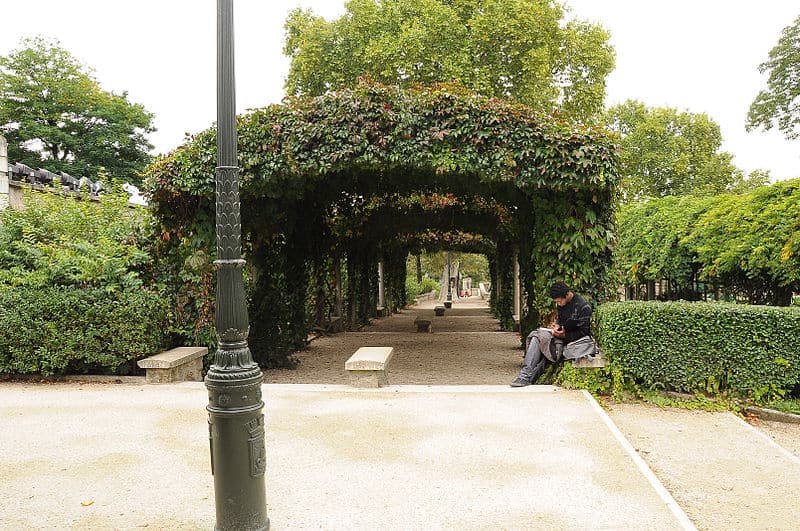
Le Parc de la Turlure – by Moonik – Wikimedia Commons
Since everyone is frantically hovering around the front end of the church, this park remains calm and quiet even on the busiest of days. There are ample nooks in which one can curl up with a book or simply bask in the sunlight from one of the benches under the trees.
The towers of the Sacre Coeur peek out through the trees of the Parc de la Turlure, giving you a unique angle of the church that not many will make the time to see.
9. Vendors at the Basilica of Sacre Coeur
Similar to the way street artists in Paris flock to where the crowds are, so too do the street vendors.
All through the outside grounds of the Sacre Coeur you’ll encounter entrepreneurial individuals with many an item to sell. From handmade jewelry, to branded clothing, to wonderful kitsch souvenirs and even the occasional crepe vendor — the Sacre Coeur becomes a one stop shop for all the bits and bobs you might need from such an excursion.
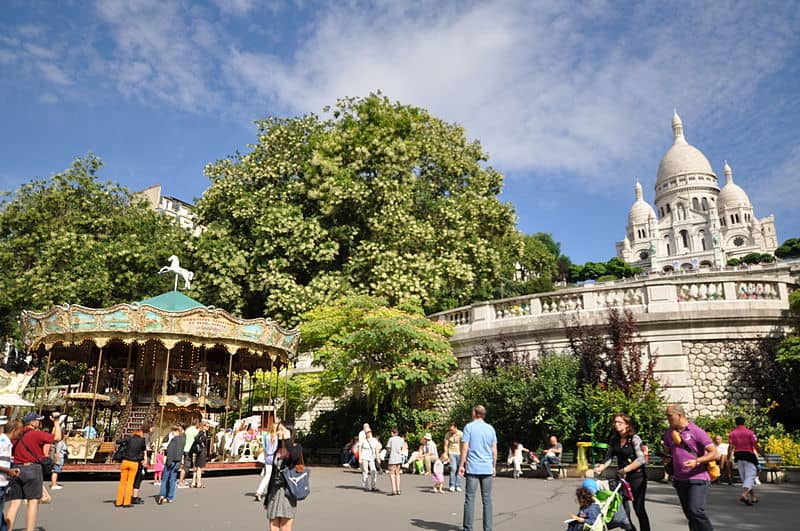
Sacre Coeur vending grounds – by Kristof Verslype – Wikimedia Commons
Most vendors at this attraction are harmless and there with the intent to simply make some easy cash from willing customers.
Beware of the “vendors” who make their sales by approaching unsuspecting individuals and placing merchandise on or in their hands before they can say no. These may be in the form of a beaded bracelet, Buddhist prayer card or a homemade CD featuring the work of the optimistic salesman.
While still harmless, these vendors are harder to say no too since the merchandise is already on your person. It’s the age old trick of gifting to someone unexpected and then asking for money at a later stage.
10. The History of the Basilica of Sacre Coeur
The Sacre Coeur is a historic and iconic part of Paris. It was only officially completed in 1914, which, when considering the age of some of the there churches in town, isn’t that long ago.
The truth is the Sacre Coeur dates way back to the times of 270 AD, when the first Christina chapel was built on the very site that the church is today.

Sacre Coeur – by David McSpadden – Wikimedia Commons
If it hadn’t already occurred to you, Sacre Coeur means sacred heart in French and is a direct reference to the heart of Jesus Christ & his divine love for all humanity.
While we may not all be able to get behind churches and religion, we should all be able to get behind love.
Planning a trip to Paris ? Get ready !
These are Amazon’s best-selling travel products that you may need for coming to Paris.
Bookstore
- The best travel book : Rick Steves – Paris 2023 – Learn more here
- Fodor’s Paris 2024 – Learn more here
Travel Gear
- Venture Pal Lightweight Backpack – Learn more here
- Samsonite Winfield 2 28″ Luggage – Learn more here
- Swig Savvy’s Stainless Steel Insulated Water Bottle – Learn more here
Check Amazon’s best-seller list for the most popular travel accessories. We sometimes read this list just to find out what new travel products people are buying.

